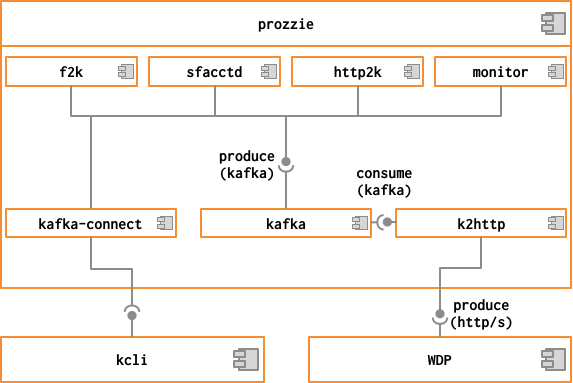Base Linux installation
Getting installation script
Automagical installation
Prozzie will be downloaded & installed if you execute the next command in a linux terminal as root user or using sudo command:
sudo bash -c "$(curl -L --header 'Accept: application/vnd.github.v3.raw' 'https://api.github.com/repos/wizzie-io/prozzie/contents/setups/linux_setup.sh?ref=0.7.0')"
Installation from github repository
Clone the repo and execute the setups/linux_setup.sh script that will guide
you through the entire installation:
Installation steps
Base prozzie installation
You will be asked for a prozzie installation path, and you must remember it at every change you want to make from now on.
If you have not installed docker or docker-compose yet, linux_setup.sh script
will install them. Next tool it needs for installation:
curl
Curl is only needed to install docker. Beyond that point, all dependencies are contained in a docker image named prozzie-toolbox.
You will be asked for the variables on Linux section of
VARIABLES.md.
The long description of these are:
- INTERFACE_IP
- Interface IP to expose kafka (advertised hostname)
- CLIENT_API_KEY
- Client API key you request to Wizz-in
- ZZ_HTTP_ENDPOINT
- You WDP endpoint
If you have any issue you can check our FAQ.
Modules configuration
After that, you can configure different prozzie connectors introducing the name or the number in the prompted menu:
1) aerohive
2) f2k
3) http2k
4) monitor
5) mqtt
6) sfacctd
7) syslog
Do you want to configure modules? (Enter for quit)
You can omit the prompt with CONFIG_APPS environment variable. For instance,
to configure only monitor and f2k, you can use CONFIG_APPS='monitor f2k', and
you will directly be asked for these related apps. Similarly, you can omit the
whole prompt if that variable is empty, i.e., CONFIG_APPS=''.
If you ever want to reconfigure a specified protocol, you can run the prozzie config wizard command.
Prozzie operation
You can start, stop, create or destroy prozzie compose with installed commands
prozzie start, prozzie stop, prozzie up and prozzie down, respectively.
To operate at low level on created compose, you can use
prozzie compose command, and it will forward arguments with proper compose
file and configurations. So, prozzie start, prozzie stop, prozzie up and
prozzie down are just shortcuts for the long version
prozzie compose [up|down|...], and arguments will be also forwarded.
Protocol installation
You can check the CLI section to know about installation of new protocols.
You can see the components installed in the next picture, so you can identify the method to use to configure each one:
Prozzie uninstall
Prozzie doesn’t provide any mechanism to uninstall itself. If you want to uninstall prozzie you must do manually.
When you install prozzie first time you must specify a prefix, by default It’s /usr/local. In this prefix, prozzie creates following directories:
${PREFIX}/share/prozzie- Contains files about prozzie cli and docker compose files.
${PREFIX}/bin - Contains the symbolic link to prozzie command.
${PREFIX}/etc/prozzie - Contains information about prozzie modules configuration.
${PREFIX}/var/prozzie/backup - Contains prozzie backup when upgrade prozzie.
To uninstall prozzie you must follow the next steps:
- Do
prozzie downto stop and delete all modules docker container. Keep in mind that prozzie will stop and won’t send data to WDP platform. - Remove
${PREFIX}/share/prozzieand${PREFIX}/etc/prozziefolders. - Remove symbolic link named
prozziein${PREFIX}/bindirectory. Ifbinfolder It isn’t necessary, then you can delete it. - Remove
${PREFIX}/var/prozziefolder and its content.
